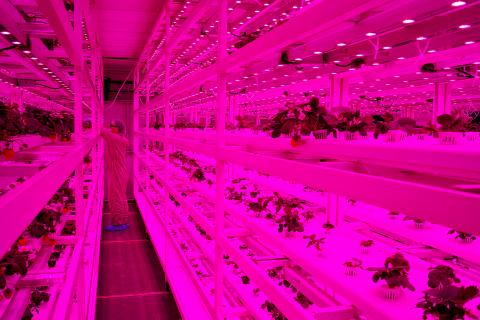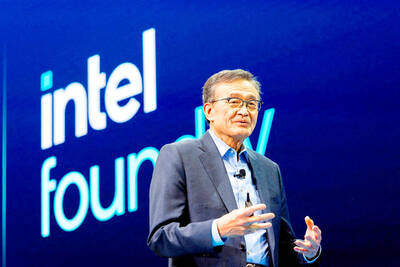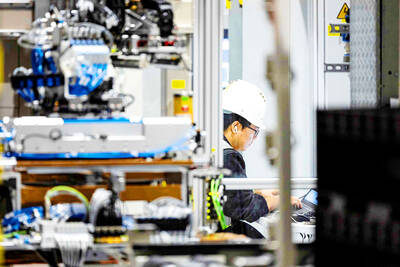Given its size, Singapore is an unlikely place for a farming revolution, but with tiered fish farms, vegetable plots atop office buildings and lab-grown shrimp, the nation aims to beef up its own food production and rely less on imports to feed its 5.6 million people.
Singapore produces about 10 percent of its food, but aims to raise that to 30 percent by 2030 under a plan known as “30-by-’30.”
The challenge is space. With only 1 percent of Singapore’s 724km2 land area devoted to agriculture and production costs higher than the rest of Southeast Asia, the pressure is on new urban farmers to answer the government’s call to “grow more with less.”

Photo: Reuters
“Whenever I talk about food security in Singapore, I tell folks don’t think land — think space. Because you can go upwards and sideways,” said Paul Teng, a professor specializing in agriculture at Nanyang Technological University.
Sustenir Agriculture is one of more than 30 vertical farms in Singapore, which has seen a doubling in so-called sky farms in three years.
The hydroponic farm grows non-native varieties such as kale, cherry tomatoes and strawberries indoors under artificial lights and sells the produce to local supermarkets and online grocers.
Sustenir last year raised S$22 million (US$16 million) from backers, including Singapore state investor Temasek and Australia’s Grok Ventures, which will be used for an expansion in Singapore and opening in Hong Kong.
Temasek is also providing funds to Apollo Aquaculture Group, which is building a S$70 million highly automated, eight-story fish farm.
Apollo says the new farm will deliver more than a 20-fold increase in its annual output of 110 tonnes of fish.
“It is too unpredictable to do things now in the traditional way,” said Apollo chief executive officer Eric Ng, citing problems with algae blooms in recent years that have wiped out farmers’ fish stocks.
Singapore has not given a total pricetag for 30-by-’30, first unveiled in March, but it has various funding schemes.
Aside from Temasek, the government has put aside S$144 million for research and development into food, and S$63 million for agriculture firms to use technology to boost productivity.
It also plans to build an 18 hectare agri-food site for indoor plant factories and insect farms by the middle of 2021.
“Investor interest in urban agriculture is rising as environmental pressures and technology developments catalyze new ways of producing food locally,” said Anuj Maheshwari, a managing director at Temasek who focuses on agri-business.
Not everyone is convinced by the focus on high-tech.
Egg farmer William Ho, 53, said that the government is putting too much stock in new agri-tech firms with no track record.
“Many of them have failed. That’s why I’m always asking the government: ‘Why don’t you invest in us old-timers. We are more practical,’” he said.
A major hurdle for urban farmers are the expensive inputs like technology that puts their products out of reach for many consumers, Teng said.
One Singaporean firm still in its infancy, but hoping to reach a mass market, is Shiok Meats, which aims to be the world’s first to sell shrimp grown from cells in a lab.
The process involves cells grown in a nutrient solution in tanks. After four to six weeks, the fluid is siphoned off and leaves behind raw shrimp mince.
Shiok is backed by Henry Soesanto, chief executive officer of Philippines-based Monde Nissin Corp, which owns British meat substitute firm Quorn.
Shiok cofounder Sandhya Sriram hopes to tap into the enthusiasm for alternative protein that propelled the market value of US-based Beyond Meat to more than US$5 billion after its debut this month.
After raising US$4.6 million in seed funding this year, Sriram said that Shiok Meats plans to sell its product in one or two premium restaurants by late next year, and by 2030 hopes to produce enough shrimp meat to feed Singapore.
“It [30-by-’30] is achievable, but it depends which part of the food industry they want to take a leap of faith on,” she said.

CHIP RACE: Three years of overbroad export controls drove foreign competitors to pursue their own AI chips, and ‘cost US taxpayers billions of dollars,’ Nvidia said China has figured out the US strategy for allowing it to buy Nvidia Corp’s H200s and is rejecting the artificial intelligence (AI) chip in favor of domestically developed semiconductors, White House AI adviser David Sacks said, citing news reports. US President Donald Trump on Monday said that he would allow shipments of Nvidia’s H200 chips to China, part of an administration effort backed by Sacks to challenge Chinese tech champions such as Huawei Technologies Co (華為) by bringing US competition to their home market. On Friday, Sacks signaled that he was uncertain about whether that approach would work. “They’re rejecting our chips,” Sacks

NATIONAL SECURITY: Intel’s testing of ACM tools despite US government control ‘highlights egregious gaps in US technology protection policies,’ a former official said Chipmaker Intel Corp has tested chipmaking tools this year from a toolmaker with deep roots in China and two overseas units that were targeted by US sanctions, according to two sources with direct knowledge of the matter. Intel, which fended off calls for its CEO’s resignation from US President Donald Trump in August over his alleged ties to China, got the tools from ACM Research Inc, a Fremont, California-based producer of chipmaking equipment. Two of ACM’s units, based in Shanghai and South Korea, were among a number of firms barred last year from receiving US technology over claims they have

It is challenging to build infrastructure in much of Europe. Constrained budgets and polarized politics tend to undermine long-term projects, forcing officials to react to emergencies rather than plan for the future. Not in Austria. Today, the country is to officially open its Koralmbahn tunnel, the 5.9 billion euro (US$6.9 billion) centerpiece of a groundbreaking new railway that will eventually run from Poland’s Baltic coast to the Adriatic Sea, transforming travel within Austria and positioning the Alpine nation at the forefront of logistics in Europe. “It is Austria’s biggest socio-economic experiment in over a century,” said Eric Kirschner, an economist at Graz-based Joanneum

France is developing domestic production of electric vehicle (EV) batteries with an eye on industrial independence, but Asian experts are proving key in launching operations. In the Verkor factory outside the northern city of Dunkirk, which was inaugurated on Thursday, foreign specialists, notably from South Korea and Malaysia, are training the local staff. Verkor is the third battery gigafactory to open in northern France in a region that has become known as “Battery Valley.” At the Automotive Energy Supply Corp (AESC) factory near the city of Douai, where production has been under way for several months, Chinese engineers and technicians supervise French recruits. “They